DisneyToon Studios/Walt Disney Home Entertainment (August 17 2004), single disc, 75 mins plus supplements, 1.78:1 anamorphic widescreen, Dolby Digital 5.1 and DTS Surround, Rated G, Retail: $29.99
Storyboard:
Apparently set just after the events of the famous Dumas story, in 17th Century France, we find Mickey, Donald And Goofy working as janitors in Queen Minnie’s castle. Though they are way, way, way down in the chain of things, they dream of becoming Musketeers like their heroes – something that all seems lost when Captain Peg-Leg Pete uses them in a scam to oust Minnie so that he can rule all. He awards them Musketeer positions as Minnie’s private bodyguards, knowing that their ineptitude will play a big part in his being able to take the throne. But the boys have a trick up their sleeve: they know they can overcome their shortcomings (Mickey’s lack of stature, Donald’s lack of courage, Goofy’s lack of brains) by working together, something that doesn’t quite work out first time around, which leads to a fall out of the group. Pete and his henchmen, three Beagle Boy types, make their move at a gala opera (a nice Fantasia nod), locking Mickey in jail (some excellent character work here) and leaving Donald and Goofy to patch up their differences, rescue Mr Mouse and all head to the old op’ry house for a final showdown with Pete and his boys…
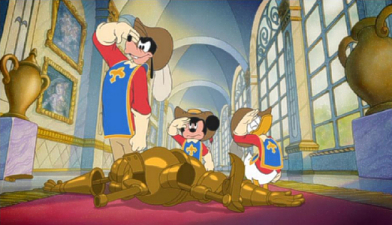
The Sweatbox Review:
With great fanfare (though not that great, since this title bypassed theaters and is being released direct to video), Walt Disney’s “fantastic three” and the cornerstone characters of the animated line up, Mickey, Donald and Goofy finally star in their first, full-length animated motion picture.
While this is technically true, Mickey and co have appeared on the big screen in major Disney features before, of course. After making a splash on the silver screen in the 1930s, Mickey saw his career sidelined in favor of more Donald and Goofy solo outings, only making the first of a couple of “comebacks” with his trademark role in the musical feature Fantasia. Ahh yes, you say, but that was just a segment in a compilation film, and while this may be true, it was The Sorcerer’s Apprentice that kick-started the whole Fantasia experiment in the first place and Mickey who gives the overall film an identifiable image.
The Mouse’s appearances in the short subjects became more and more spaced apart, until Walt suggested another comeback…this time a feature-length Mickey adventure based around the classic Jack And The Beanstalk fable. Since budget constraints and the onslaught of World War II had meant cutbacks at the studio, the proposed feature was paired with another story, the semi-Dumbo sequel Bongo, and combined in the 1947 film Fun And Fancy Free, again with Mickey’s half of the film not only being the more dominantly marketed sequence (it was still sold as a Mickey feature), but also the segment that stands up and is the most remembered today.
Mickey And The Beanstalk, from Fun And Fancy Free, really did start the idea of using Mickey as an “actor”, placing him in various roles (it was also the last time Walt would speak for Mickey, with Jim MacDonald taking over mid-production, and the introduction of the sleeker design that we still associated with the mouse today). Thirty years after the last Mickey short, he made another comeback, after years spent in the television wilderness, again as an “actor for hire” in Mickey’s Christmas Carol, the Oscar-nominated featurette which featured Mickey as Bob Cratchit, with Donald and Goofy in supporting roles. Though again, it wasn’t a feature, it did receive top billing over a re-issue of The Rescuers.
Almost ten years later, Mickey, Donald and Goofy were pressed into action again for another roughly half-hour featurette, The Prince And The Pauper, and it’s from that film that this new title seems to take its stylistic inspiration. Although none of the films mentioned above could be technically classed as full-length, I do think there is more validity to calling Fun And Fancy Free a Mickey feature rather than this new film, which barely stretches to an hour (its TV-friendly 67 minute run time includes a seven minute credit scroll) and sometimes feels like an extended, but extremely well executed, original episode of Mickey MouseWorks or House Of Mouse.
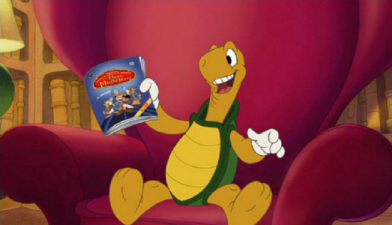
Actually, that may be a little harsh: as a fun return to the screen for the classic characters, The Three Musketeers concept is as good as any of the mooted post-Pauper projects that have failed to materialise, and the very mention of this cast and the title is sure to get even the most jaded fan excited, as they are the ideal fit. Just imagine the possibilities! Well, for the most part, they have been realised, and The Three Musketeers, while it takes great liberties and has nothing to do with Alexander Dumas’ original novel, chortles along for its rollicking length with verve and true respect for its iconic leads, coincidentally arriving in the year that Mickey celebrates a 75th anniversary and Donald his 70th birthday.
As you can well imagine, I found a great deal to enjoy in The Three Musketeers, not least the style of the film, which reminded me for some reason of the Gene Kelly “let’s put on a show” films from MGM’s heyday. Whereas previous “historically set” Mickey adventures have attempted to immerse the viewer in that particular world (be it foggy London or a Giant’s castle), The Three Musketeers never once asks you to suspend belief that one is watching three of the last remaining Hollywood stars from the Golden Age “starring” in a new film. The trio retain their classic personas, and it’s just nice to have them on screen again as we remember them.
In fact, sometimes, it doesn’t feel like a new film at all, with character models and actions absolutely so spot on, that certain sequences will have even die-hards like myself wondering if this wasn’t a “lost” Walt-era cartoon brushed up and beautifully restored. The give-away, mainly, is the too clean digital imaging, and the fine lines of the character animation, and while there are a large number of fully 24-frame animated shots, it’s mostly all done on twos (nothing that ever stopped the majority of animated features), but still looks great.
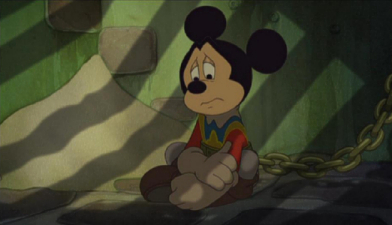
Director Donovan Cook’s first job at Disney was co-ordinating production of The Prince And The Pauper, so he obviously has some experience with the cast! He here gets a solo outing, after co-directing duties on the surprisingly resonant Return To Never-Land, and could be a name to watch for, with a varied career already behind him. He services this film well enough, and sometimes recalls the spirit of the theatrical shorts rather than any feature film Mickey and co have appeared in, and for once the angles are very imaginative and the timing throughout does not play as just some Warner Brothers Looney Tunes-in-disguise moments, but that of classic Disney itself.
Interestingly, apart from the involvement of Cook, the film does share another couple of traits with The Prince And The Pauper. Setting things up, and narrating the tale, is a French-accented turtle Troubadour, who, Pauper-style, puts lyrics to the famous compositions of Beethoven, Tchaikovsky and so on, providing fun interludes with familiar sounding themes (and a return to a link between Mickey and classical music). These scores are adapted by The Rescuers Down Under (paired with Pauper in theaters) composer Bruce Broughton, making a welcome return to big, rousing Disney music, though the idea is nothing new for him. The whole using-classical-pieces-with-new-comedy-lyrics concept was worked over and over on the Animaniacs series, which Broughton also scored, but these new versions are fun nonetheless and work well in the story, with a soft self-awareness that never mocks itself.
Staying with the soundtrack, and the usual gang of Disney character voices are on hand to provide our beloved leads with the vocals we’ve come to expect. Starring again as Mickey and Minnie are husband and wife team Wayne Allwine and Russi Taylor. It’s obviously a tough act to follow Walt Disney and Jim MacDonald in the role of Mickey, but Allwine has been doing this for a while now, and comes off sounding about right (I always find his voice a little more “closed in” than Walt or MacDonald’s mouse). Disney animator Tony Anselmo (who also contributes artistically) again speaks for Donald, a role he has been “filling in” for the original since Clarence “Ducky” Nash passed away in 1984, and Bill Farmer, who I think always does an absolutely bang on Goofy, sounds just as warm as Pinto Colvig did back in the day.
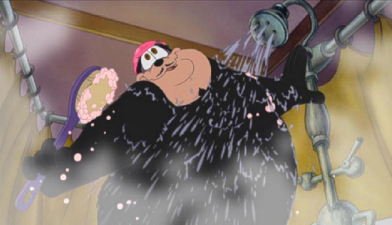
Joining them all are regular Disney cast members Jim Cummings (as Pete, complete with his original peg-leg), Tress MacNeille as Daisy (sounding a little more self-confident than we’re accustomed to), Rob Paulsen (long of Disney’s TV sound-a-like voices) and April (daughter of Paul) Winchell, as Clarabelle, here playing against type as a misguided “villainess” of the piece. All do well with the script, and though only a few modern lines creep in, it’s all done in good fun and there’s nothing questionable about the material – whatever attempts have been made to keep the characters up to date has been done well within their confines. Parents should have just as much fun revisiting these guys as their kids will have.
Switching to the visuals, and for a medium that is supposedly running out of steam, this traditionally animated feature looks refreshingly vibrant and colorful. Perhaps too colorful – more than once I felt the overly bright hues could have been toned down in the transfer and the lack of shadows and detail (though in keeping with the classic look) didn’t help that the characters sometimes “melded in” with the backgrounds (which are rendered with the traditional “rough paper” look). Though I guess the ideal was the short subjects of the 40s and 50s, even those didn’t feature the eye-popping brightness of this color palette. It’s not a big deal: I found reducing the brightness and upping the contrast on my display gave me more of a “film look”, something that these digital transfers can sometimes take away, leaving the animation process “exposed” and looking too clean. Sometimes, grain is good.
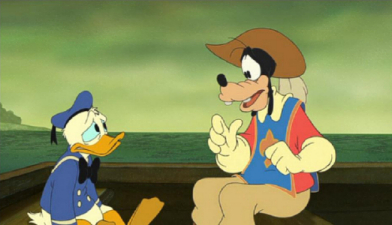
Minor bugbears aside, Mickey, Donald, Goofy: The Three Musketeers is a good old-fashioned (are we allowed to say that?) romp with some of our favorite Disney characters. The animation may not quite be the “full theatrical quality” that has been rumored (though it’s quite a close match for The Prince And The Pauper for production value), but this IS due in part to the wishes to retain the more flat, cartoony approach of the classic shorts. Computers are used only very sparingly in a few shots, and I thought some use of multiplaning would have helped here and there, but for all its simplicity there is a lot more to marvel at in the visuals, not least the return to the original design models, the reinstating of Pete’s peg-leg, and some references (acknowledged or not) that crop up throughout: I felt that the Troubadour resembled a long-lost European cousin of Toby Tortoise on more than one occasion, and there are many more in-jokes and “hidden Mickeys” for fans to keep an eye out for.
It’s moments like these that reveal the little extra care and attention that have gone into The Three Musketeers, and while the DTV stigma may prevent it from becoming a classic in the way that Mickey And The Beanstalk has, it will certainly stand up against Mickey’s other roles such as Christmas Carol and Prince And The Pauper (and much, much more warmly embraced than the aberration that is Twice Upon A Christmas will ever be). After many years of asking for the Australian animation crew to be allowed to show us the goods on anything but a Disney sequel, they have provided us with this exemplary and colorful mix of old and new styles. Mickey’s Three Musketeers shows that there’s a lot more life in the seventy-five year old star yet, and that traditional, hand drawn Disney animation is still just as vital as it ever was!
Is This Thing Loaded?
Whereas The Lion King 1½ was the recipient of a second disc of extras (okay, so all that space for the Virtual Safari had to be found somewhere!), The Three Musketeers seems only worthy of a few bonuses. Most publicised about this edition is the introduction of Disney’s new FastPlay and EasyFind “technologies”, which allow good parents to merely shove the disc on and leave the kids to it instead of sitting and watching it with them (okay, I know…just kidding).
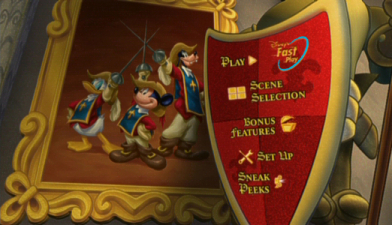
The idea behind FastPlay is that, once the disc kicks in, the program will unspool itself without any more menu options to choose from, playing the main feature (after a “helpful” amount of forced previews) and a selection of video-based extra features. That’s it, and it’s that simple, reducing the very interactivity of a DVD back to the dark ages of VHS and, to an extent, LaserDisc, when play was all one had to, or could, do. Actually, and all jeering aside, I an see where this may come in handy for repeat viewings on select titles, where parents can be assured the title will play on it’s own, but if you want to skip this option be quick to select the standard menu option, or else the film will begin automatically without warning.
EasyFind is another new approach to Disney DVD, which basically groups together various types of media options into their respective categories (Music And More, Games And Activities, Backstage Disney, etc). To be honest, while I could see that the FastPlay device is a simpler way of using DVD, I didn’t see the need to brand what is a pretty standardized way of using the interactive features on a disc, and wondered if this extra feature actually confused matters more by introducing an extra page to navigate through the bonuses.
On to the extras proper, and starting us off is the usual selection of “coming soon” Sneak Peek previews, here promoting Aladdin: Special Edition, The Lion King II: Simba’s Pride, Mickey’s very-scary-looking Barbie-wannabe Twice Upon A Christmas, and, via the additional Peeks section, Mulan: Special Edition, Home On The Range, Toon Disney’s House Of Mouse, the Princess Collections and Disney’s Magical Quest 2 for Game Boy Advance.
Getting the dross out of the way and a Cast Commentary must have sounded like a great idea after how Brother Bear’s Moranis and Thomas track turned out. However, whereas there they had two expert improvisational comedians at work, here they have scripted character parts as performed by the principal voice cast. After a fairly entertaining opening, the track slips into predictable territory, with a little petty squabbling, telephone calls, etc, which really none of which really adds anything. By the way, and proving that this could never have been stretched to feature length, this feature only plays on one scene from the movie and begins to run out of steam at that. Couldn’t a decent, real director commentary have been recorded for us fans who are actually quite interested into what went into such a project?
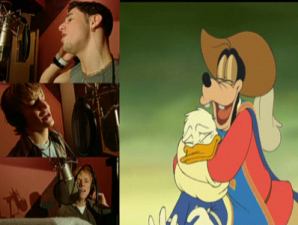
Another one for the kids is a Song Selection that basically replays the song sequences from the movie, lock, stock and barrel, with subtitled lyrics inviting a sing-along, while rounding up the musical offerings is the Three Is A Magic Number music video, sung by Stevie Brock, Greg Raposo and Matthew Ballinger, from various other Disney projects. Surprisingly, the song doesn’t play as part of the long end credit scroll, leaving the much more enjoyable Bruce Broughton score to close things out. The over-produced song, cut to fast-paced images of the boys in the studio and the film split-screen 24-style, is typical of other boy-band pop out there, and for anyone with memories of the original, keep away…this sounded like a mess to me (and, no, I’m not that old!), but at least it was a full-length three-minute piece and not just a typical Disney 30-second commercial for the soundtrack CD.
In Games And Activities, there are a couple of fun time wasters. First up is Opera-toon-ity, set in the film’s opera house and “hosted” by the Troubadour in voice-over. While not really a game (ahh, see where the “activities” come in?), the player must select a backdrop and “cast” a singer to perform a song in the opera house. There are a number of different permutations, but ultimately only three alternate songs (each singer will sing the same song no matter what the backdrop or costume is). Where the entertainment lies is in hearing more classical music accompanied by silly lyrics, though these ones are decidedly more kid-oriented than story based, covering topics such as favorite foods, late homework and loose underpants! The songs only last a minute or so, accompanied by on-screen sing-along lyrics, with some simple but effective image manipulation providing the illusion of new animation.
The Many Hats Of Mickey is perhaps the most meaty of the bonuses, at least for aficionados, due to the history of the character that is involved. Treading through Mickey’s career, this would have been great as the featurette it was originally announced as, but works well enough in the fashion it has been created. While again not much of a game this has the Troubadour turtle return in voice over to explain Mickey’s historical and literary roles. What was quite impressive is that the feature doesn’t just skimp by on the obvious Beanstalk, Christmas Carol and Pauper highlights, but also delves back into some unexpected clips from Giantland (1933, and another take on the beanstalk story), The Castaway (1931, inspired by Robinson Crusoe), Thru The Mirror (1936, from Lewis Carroll’s Alice stories), Gulliver Mickey (1934, from Swift’s classic), and The Brave Little Tailor (1938, from the Grimm story). Each selection is accompanied by a brief film clip, making it a welcome look back at similar roles and providing something of a backdrop context to the look of the main feature itself.
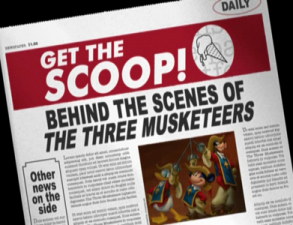
In Backstage Disney, Get The Scoop continues the theme introduced in the Cast Commentary that Mickey and the gang really are actors making a movie. Ostensibly a behind-the-scenes look at the making of the film, we do hear from director Cook on how Walt had plans for several Mickey features and how and why this is supposedly the very first one to come to fruition (even though we’re still waiting for a bona fide Walt Disney Feature Animation theatrical outing folks)!

Running close to ten minutes, there are some glimpses at the production process, and the “reporter” style of the host proves an amusing way to keep kids interested. There’s enjoyment to be had in the crew discussing the “actors” approach to their roles (“Why did they take the role? They wanted to go to France!”), but it gets a bit silly towards the end when it reverts into predictable “Goofy and Clarabelle really did fall in love” talk. Still, better than no look at all, and director Donovan seems like a right character himself!

Finally, Deleted Scenes Off The Cutting Room Floor presents roughly five-minutes of, well, deleted scenes rescued from off the cutting room floor! An original storybook opening lampooning the traditional approach to Disney films may have been fun, but the comic book substitute finally used brings it up to date somewhat. Commentary from DisneyToon Studios exec Brian Snedeker is available if required, though it’s mostly of the “we cut this to move the story along” variety and a serious feature length track on the feature itself would have been preferable. In fact, the two middle scenes I feel would have made exceptional additions, beefing up the Troubadour’s ultimately rather short on-screen time and using the comic book framing device (drawn in the authentic Carl Barks style) more in the way the Winnie The Pooh books worked, with characters moving between panels. This would have added an extra layer to the film, especially since, after the opening, the comic is quickly forgotten and not brought back into play anywhere down the line. However, I guess these might have been cut for timing reasons more than anything (ever noticed how all these DTVs all share a 66-or-so minute running time perfect for a 90-minute TV airing with commercials)?
All in all, a decent, if not disc-blowing selection of extras that reveals little about the film itself, but offer up an assortment of additional viewing and time with the characters. A decent trailer and some kind of feature length discussion would have topped off a perfect package for kids and fans alike, but I guess we’ll have to simply make do with the more than fun movie on its own.
Case Study:
The Disney inserts remain! In fact, The Three Musketeers gets a bunch of them, including a traditional chapter index, and a quarter-sized booklet offering some coloring in fun and money off vouchers. Finally, a card promoting the new FastPlay and EasyFind features offers a weblink to where feedback can be left. As I say above, I can imagine where the FastPlay could come in handy, but EasyFind isn’t easy at all and puts another page of text in front of things one wants to find quickly. It’s a decent touch of Disney to ask for feedback though.
Ink And Paint:
As mentioned above, I found the perfect looking digital transfer on offer here to be too clean and bright, with a little tweaking on my display producing better results. Blacks are never too deep, or deep enough, revealing a lighter than usual “exposure”. Colors are perhaps overly vibrant, but hold their positions and lines are sharp, again perhaps a little too detailed, with a teensy amount of edge-enhancement detected. An upping of the contrast and the subtraction of a little bit of brightness meant I found things were not so flat-and-bland looking, and much more resembled a feature length outing rather than the direct-to-video route this has taken. Blown up on my DLP projector, the hard lines became a little softer and the progressive scan provided a much more filmic look to the overall “print”. It’s a good transfer, if one that doesn’t help disguise the computer ink and paint process and DTV roots of the project any.

Scratch Tracks:
As usual with Disney’s direct-to-video fare (and probably because they take up such little space on the disc due to shorter length), we are given DTS amongst the multiple soundtrack choices. For a change, I noticed the DTS surrounds did stand to attention a little more than the Dolby Digital 5.1 this time out, and the former does again pack a bigger punch in the bass section. Those with Dolby capabilities needn’t worry though: the sound was perhaps a little cleaner in the mid-range and is more than acceptable. It’s a typical cartoon soundtrack, with wacky effects and crazy directional spots that adds to the overall enjoyment of the film itself, and even working the system up in a couple of the exciting moments where the score comes into its own (and plays out over the credits rather than the over-hyper pop-single included in the bonuses). French and Spanish dubs and subtitles are also included.
Final Cut:
While not hitting the heights of the classic feature-length Mickey adventure we’d been hoping for (and had been rumored), The Three Musketeers still plays very well, and is sure to delight those who catch it. There is much to be said for spending an hour or so with these timeless characters again, and to see them in such anniversary years in a new high-profile project is heartening, whatever the circumstances. Kids familiar with the gang will be enchanted by this new film, and causal adult fans will recall watching the shorts in theaters or television and have fun revisiting their childhood.
Animation nuts may whine a little about the sometimes simplistic look, and it’s true that some subtler colors and some light and shadow work would have provided a deeper look and gotten away from the overly bright and flat images. Disney’s disc presents the film in a fine way, and it’s well worth a purchase by any Disney collector, who may find that, even if it isn’t an all-time great, it’s been made with love and affection by a bunch of guys who clearly love the characters and wish to keep them, in this day and age, the way they were intended. All for fun, indeed!
 | ||
 |






